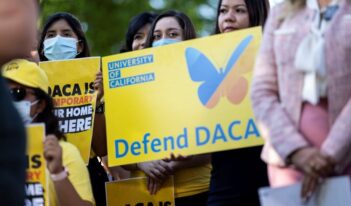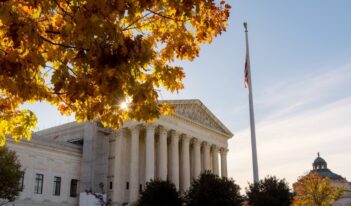
Administrative law principles led the Supreme Court to deliver a victorious but unsatisfying and uncertain conclusion for migrants.
This past term, the U.S. Supreme Court issued its highly anticipated decision in Department of Homeland Security v. Regents of University of California, rejecting the Trump Administration’s attempt to rescind the Deferred Action for Childhood Arrivals (DACA) program. DACA provides protections from deportation to certain migrants, namely “Dreamers” who entered the United States as children with their parents.
In a 5-4 decision, the Court held that the attempt to end the DACA program amounted to “arbitrary and capricious” action in violation of the Administrative Procedure Act (APA). This decision was a much-needed victory for Dreamers that also raises three crucial questions: First, what are the terms of the victory? Second, what limits does the Court’s decision impose? And finally, what does the decision teach us about the lives of Dreamers?
The plaintiffs in this case secured a surprising win by tapping into the majority’s interest in affirming basic principles of good governance. But the horizon for their victory remains uncertain, and the decision continues to hide the human costs borne by Dreamers.
As a decision, Regents does not offer much of an affirmation of DACA nor of the Dreamers that DACA protects. Rather, Chief Justice John Roberts, who authored the opinion, focuses his analysis exclusively on the Trump Administration and its erratic governance style. Stretches of the opinion read as a treatise on good governance—that is, on transparent, rational, and logical agency decision-making.
When deciding to rescind DACA, the U.S. Department of Homeland Security (DHS) had presented several justifications for rescission, but it did so in two different memoranda that were issued at different moments both before and after litigation over the rescission began. As a result, it was hard to take the government at its word that its proffered reasons for rescission were its actual reasons for rescission, instead of what they plainly appeared to be: positions of convenience articulated to avoid the costs and embarrassment of a do-over.
Ultimately, the Court declined to consider those additional justifications in assessing whether the rescission complied with APA requirements. Citing the 1971 decision in Citizens to Preserve Overton Park v. Volpe, the Court disregarded the second memorandum as a post hoc rationalization—that is, as an explanation that was not contemporaneous of the rescission decision—and therefore qualified as agency action that “must be viewed critically.” For this reason, the Court did not consider those additional explanations when deciding whether the rescission complied with the APA.
Because some of the reasons in the second memoranda might have justified the rescission on the merits, Chief Justice Roberts’s opinion invited the concern that he and the rest of the majority were being excessively formalistic. In his dissent, Justice Brett Kavanaugh quipped that “the Court’s decision seems to allow the Department on remand to relabel and reiterate the substance” of the second memorandum and survive judicial review.
In response, the Chief Justice explained that the Administration’s “and one more thing” approach to terminating DACA flouted core values that formal administrative procedures protect—such as agency accountability, the importance of instilling confidence in the public, and “the orderly functioning of the process of review.” For the majority, the method by which DHS pursues rescission is just as important as the reasons for that rescission. It is a basic principle of good governance that in order for agencies like DHS to have legitimacy, they must explain and justify their actions with a minimum degree of clarity and reason. Perhaps this rationale explains the formalistic approach taken in Regents—from the Court’s perspective, better to be a stickler about rules and protocol when the legitimacy of enforcement agencies within DHS is at stake.
The other aspect of the Court’s lecture on good governance involved the nature of the consequences that would flow from a shift in policy like rescinding DACA.
As presidential administrations turn over, especially across party lines, newly appointed agency officials often feel pressure to undo policies created by their predecessors. Because people organize their lives around policies such as DACA, many administrative law rules and concepts exist to slow the process by which this change in administration translates into a change in the real world.
DACA gives beneficiaries the chance to build careers, support family members, and secure driver’s licenses. Ending the program means unmooring hundreds of thousands of non-citizens from lives they built. Good governance means accounting for this reality and for the costs generated by such a shift in policy. As the Court explained, had the Administration adequately considered the “reliance interests” of the people and communities who benefit from DACA, the Administration might “have considered a broader renewal period based on the need for DACA recipients to reorder their affairs.”
Regents is an incredible victory for DACA beneficiaries. But the decision also illustrates the limits of the good governance rationale in the context of ongoing struggles by lawyers, advocates, and organizers to expand immigrant rights.
First, the decision was a narrow one. The majority opinion still leaves plenty of room for the Trump Administration to set policies grounded in racism, which appears to be a discernible impulse motivating the rescission policy. Only Justice Sonia Sotomayor remained open to the idea that anti-Mexican animus, in addition to administrative incompetence, might have informed DACA’s rescission. No other Justice joined her concurrence.
In allowing for subterfuge and pretext, Regents resembles the census case from last term, Department of Commerce v. New York, which concerned the Secretary of Commerce’s attempt to include a question about citizenship on the 2020 census survey. The U.S. Department of Commerce had purported to include the citizenship question “for purposes of enforcing the Voting Rights Act.” Once again writing for a divided Court, Chief Justice Roberts zeroed in on the “significant mismatch” between the Secretary’s decision and the stated rationale, which had given the entire story a “contrived” feel.
“If judicial review is to be more than an empty ritual, it must demand something better than the explanation offered for the action taken in this case,” Chief Justice Roberts explained. Significantly, he did not address whether the citizenship question was motivated by anti-immigrant sentiment—which many suspected. As some scholars have pointed out, the Chief Justice’s opinion in Department of Commerce sent the unmistakable message that the Trump Administration could continue governing in a racially divisive manner if it was willing to do a better job of hiding its true motivations. So it seems with Regents.
Second, the Regents decision demonstrates the difficulties of translating legal victories into actual change. The day after the decision was issued, the U.S. Immigration and Citizenship Services—the agency within DHS that processes DACA applications—issued a statement that the “Court opinion has no basis in law and merely delays the President’s lawful ability to end DACA.” This statement of agency disobedience concludes with a call for the U.S. Congress “to provide a permanent solution for these illegal aliens.”
Just yesterday, DHS announced that it would reassess the future of the DACA program, including re-rescinding the program. In the meantime, DHS has decided to shorten any new renewal grants to one-year periods, instead of the two-year grants that were previously available. This announcement leaves DACA beneficiaries safe for the moment, but worse off than before. As for new DACA applicants, DHS stated that it would decline to consider them at all. All of this uncertainty suggests that over time, Regents may amount to an empty or merely symbolic victory.
As a whole, Dreamers have led extraordinary lives, which lends a rightfully earned kind of aura to their presence in modern political life. Much of the coverage surrounding DACA has focused on the program’s successes, especially as measured by Dreamers’ economic contributions and educational achievements.
But this story of success obscures the different ways that Dreamers suffer and toil as beneficiaries of such an unstable program. Regents highlights how the good lives that Dreamers lead rely in part on a fantasy in which talent, hard work, and moral innocence will eventually be rewarded—must be rewarded. As the humanist Lauren Berlant observes, in an unequal society, promises of a good life amount to “a fantasy bribe” that justifies exploitation.
I have argued that fantasies of the “good life” place migrants on track to meet a kind of slow and premature death. Although this assertion may strike some as extreme, public health scholars are beginning to document the different ways that immigration status can lead to poorer health outcomes. In the context of DACA specifically, the uncertainty surrounding the fate of this program appears to undermine any mental health benefits the program creates. That uncertainty does not appear to be ending with the Regents decision.
Ultimately, Regents reaffirms that courts can still play a role in curbing the worst of the federal government’s tendencies by ensuring that policies are rational and reasonable—that is, not arbitrary and not capricious. But curbing the worst of what this Administration does still does not offer a meaningful life to hundreds of thousands of Dreamers waiting for a firm answer to the question of whether they can plan for tomorrow.
This essay is part of a series entitled The Supreme Court’s 2019-2020 Regulatory Term.




